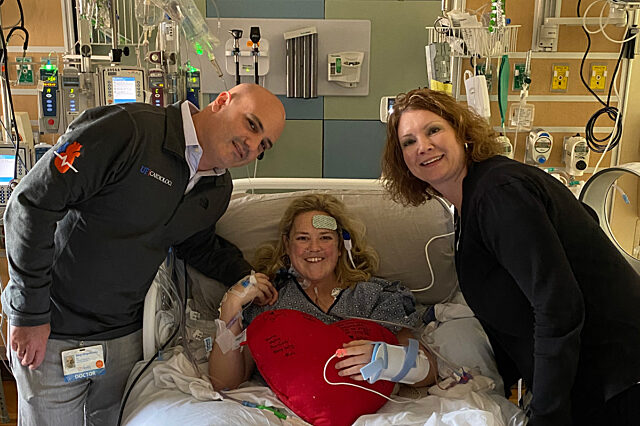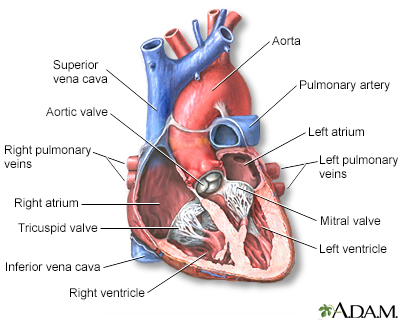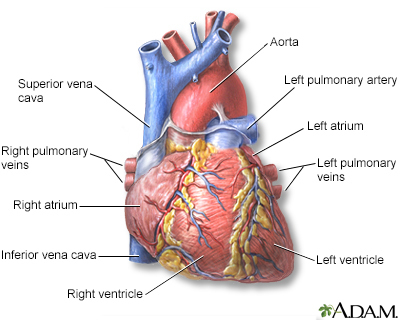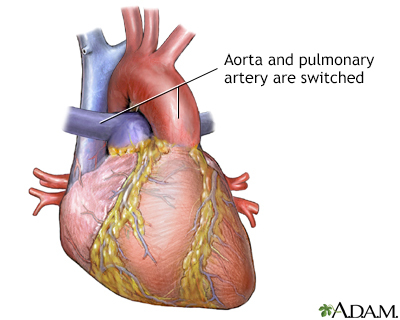Heather’s Lifelong Battle
Heather Lowery’s parents were told that she would likely not live to be 3 months old. At 36, Heather has proved them wrong and has set an example for adults…

Update your location to show providers, locations, and services closest to you.
Transposition of the great arteries (TGA) is a heart defect that occurs from birth (congenital). The two major arteries that carry blood away from the heart -- the aorta and the pulmonary artery -- are switched (transposed).
d-TGA; Congenital heart defect - transposition; Cyanotic heart disease - transposition; Birth defect - transposition; Transposition of the great vessels; TGV
The cause of TGA is unknown. It is not associated with any one common genetic abnormality. It rarely occurs in other family members.
TGA is a cyanotic heart defect. This means there is decreased oxygen in the blood that is pumped from the heart to the rest of the body.
In normal hearts, blood that returns from the body goes through the right side of the heart and pulmonary artery to the lungs to get oxygen. The blood then comes back to the left side of the heart and travels out the aorta to the body.
In TGA, venous blood returns normally to the heart through the right atrium. But, instead of going to the lungs to absorb oxygen, this blood is pumped out through the aorta and back to the body. This blood has not been recharged with oxygen and leads to cyanosis.
Symptoms appear at birth or very soon afterward. How bad the symptoms are depends on the type and size of additional heart defects (such as atrial septal defect, ventricular septal defect, or patent ductus arteriosus) and how much the blood can mix between the two abnormal circulations.
Symptoms may include:
The health care provider may detect a heart murmur while listening to the chest with a stethoscope. The baby's mouth and skin will be a blue color.
Tests often include the following:
The initial step in treatment is to allow oxygen-rich blood to mix with poorly oxygenated blood. The baby will immediately receive a medicine called prostaglandin through an IV (intravenous line). This medicine helps keep a blood vessel called the ductus arteriosus open, allowing some mixing of the two blood circulations. In some cases, an opening between the right and left atrium can be created with procedure using a balloon catheter. This allows blood to mix. This procedure is known as balloon atrial septostomy.
Permanent treatment involves heart surgery during which the great arteries are cut and stitched back to their correct position. This is called an arterial switch operation (ASO). Prior to the development of this surgery, a surgery called an atrial switch (or Mustard procedure or Senning procedure) was used.
The child's symptoms will improve after surgery to correct the defect. Most infants who undergo arterial switch do not have symptoms after surgery and live normal lives. If corrective surgery is not performed, the life expectancy is only months.
Complications may include:
This condition can be diagnosed before birth using a fetal echocardiogram. If not, it is most often diagnosed soon after a baby is born.
Go to the emergency room or call the local emergency number (such as 911) if your baby's skin develops a bluish color, especially in the face or trunk.
Call your provider if your baby has this condition and new symptoms develop, get worse, or continue after treatment.
Women who plan to become pregnant should be immunized against rubella if they are not already immune. Eating well, avoiding alcohol, and controlling diabetes both before and during pregnancy may be helpful.



Bernstein D. Cyanotic congenital heart disease: evaluation of the critically ill neonate with cyanosis and respiratory distress. In: Kliegman RM, St. Geme JW, Blum NJ, Shah SS, Tasker RC, MBBS, Wilson KM, eds. Nelson Textbook of Pediatrics. 21st ed. Philadelphia, PA: Elsevier; 2020:chap 456.
Valente AM, Dorfman AL, Babu-Narayan SV, Kreiger EV. Congenital heart disease in the adolescent and adult. In: Libby P, Bonow RO, Mann DL, Tomaselli GF, Bhatt DL, Solomon SD eds. Braunwald's Heart Disease: A Textbook of Cardiovascular Medicine. 12th ed. Philadelphia, PA: Elsevier; 2022:chap 82.
Well A, Fraser CD. Congenital heart disease. In: Townsend CM Jr, Beauchamp RD, Evers BM, Mattox KL, eds. Sabiston Textbook of Surgery: The Biological Basis of Modern Surgical Practice. 21th ed. Philadelphia, PA: Elsevier; 2022:chap 59.


Heather Lowery’s parents were told that she would likely not live to be 3 months old. At 36, Heather has proved them wrong and has set an example for adults…

Robert “Bobby” Murray, 34, was born in Hollywood, Florida on Jan. 23, 1985 – during a decade in which long-term survival into adulthood for a person with…
